#a pagan in a culturally christian world
Note
Hi Connie, I hope you and your family are feeling better today. Sending you lots of love!! 💞
Thanks nonny!
I'm allowed to go back out into the world so I did some gift shopping today and I am *wiiiiiiiiped*.

4 notes
·
View notes
Text
BUT SERIOUSLY THOUGH I FUCKING HATE THAT ARGUMENT THAT THE SERIES SUCKS BECAUSE IT DIDN'T COME FROM A CHRISTIAN PERSPECTIVE
if you genuinely believe that shit I need you to do me a favor and jump into the nearest active volcano
#loki#'this series sucks because it tried to be authentic to the actual cultural and religious world-view the character came from'#YEAH HOW ABOUT YOU JUST JUMP RIGHT INTO THAT THERE VOLCANO. JUST RIGHT IN. DON'T EVEN LOOK FIRST.#'I know not everyone is Christian and people believe different things'#UM YEAH BUT ALSO HAVE YOU FUCKFACES CONSIDERED THE FACT THAT THOSE OF US WHO /AREN'T/ CHRISTIAN HAVE HAD ENTIRE CULTURES ERASED#IN THE NAME OF YOURS? OR THE FACT THAT WHEN WE /DO/ MAKE IT INTO MODERN MEDIA IT'S ALMOST ALWAYS A REALLY DAMAGING PORTRAYAL?#the one fucking time I've seen a shoutout to paganism in a major production and in the MCU OF ALL FUCKING PLACES#that was actually done in good faith FOR ONCE#you assholes shit on it because you didn't get your straight ship#take your idea of cultural/religious superiority and shove it
10 notes
·
View notes
Text
like most Christian movies risen is cheesy and biblically dubious at times and gets loads of cultural stuff wrong for the sake of being recognizable to a primarily American audience but I'll readily admit the poor roman tribune's absolute bafflement at these religious weirdos who keep talking about love and stuff has me cackling unhingedly
Like, is it sound biblical doctrine and is it historical believable? No? Is it hilarious and do I enjoy seeing this random shmuck lose his mind going through what's essentially a very disturbing psychological thriller from his pov while the disciples are overflowing with joy? You bet??
The guy is dealing with horrifyingly decomposed dead bodies trying to find the right cadaver and previously sane soldiers going crazy and dead men being spotted alive and strange supernatural phenomena and angry gods and unexplained madness and religious fanatism spreading like a contagion, and meanwhile the disciples (and Jesus) are all like HELLO BROTHER WOULD YOU LIKE TO HEAR ABOUT THE BEST NEWS EVER :D :D :D
#Help my man Clavius he didn't ask for none of this#I gotta admit this is the first time in a while I've enjoyed any part of a Christian movie#even if most of it has me rolling my eyes and going “THAT'S not how it happened”#THE DISCIPLES WOULDN'T PRONOUNCE THE NAME OF GOD AND THE HOLY SHROUD IS BOGUS (for starters)#And there was no stranger - much less a roman - when Jesus appeared to the apostles#But I AM having fun with the tonal dissonance#Poor clavius is dreaming of blood and storms and his sanity is crumbling to dust and it feels like the end of the world#while to everyone who knows what's going on it's the single greatest thing that has ever happened and ever will#Risen 2016#Resurrection#Bible movies#(Also in the list of things that get on my nerves no the spreading of the Gospel didn't hinge on one roman protecting the apostles)#(I hope they psychologically disturb that man some more he doesn't get to think he's that important)#(Centering a roman while getting some pretty basic stuff about Jewish culture wrong is also annoying)#(The beginning of the church are entirely and unambiguously JEWISH.)#(This character is like. 10 chapters too early.)#(Peter doesn't announce the Gospel to a roman until WELL after Jesus has ascended to heaven and even then it takes a direct order from God)#(And cornelius was already a follower of God and not pagan.)#(So Clavius just doesn't fit. And inserting a pagan guy as a witness to Jesus' most intimate moments with his disciples feels off)#The Gospel doesn't spill to the nations until God decrees it's time for it to happen. I don't like this romanisation#But again the first half of the movie had me laughing even though I could rant about its flaws for two hours
3 notes
·
View notes
Text

All About Imbolc
Imbolc, also known as Imbolg, celebrated on February 1st, marks the halfway point between the winter solstice and the spring equinox in early Ireland and Scotland, and also signified the beginning of the first signs of spring after all the harsh winter days. Originally a pagan holdiay in pre-Christian times, there is little in writing about the historic traditions and customs, although many historians believe it revolved around the Celtic Goddess Brigid, lambing season, and cleansing due to observed ancient poetry.
Brigid is a Goddess and daughter of the father-God of Ireland, Dagda. She is associated with quite a few things depending on the sources, but universally associated with wisdom and poetry. Other associations of hers are blacksmithing, protection, domesticated animals, childbirth, fire, and healing. She was also known as a protector of the home and the family.
Once Christianity arose, it is believed that the Goddess was syncretized with the Irish Saint Brigid by Christian monks due to the many overlapping associations. This caused Imbolc to quickly turn into St. Brigids Day and the next day into Candlemas with the rising Christian popularity, enmeshing the holiday associations together.
Today, many people have mixed the traditions and melded many associations from both religious and cultural history to celebrate their own unique way. Common ways to celebrate are making a Brigid's Cross, welcoming Brigid into the home, having a feast in her honor, cleaning the home and oneself, visiting a holy well, and in some parts of the world they still hold festivals and processions carrying a representation of Brigid. Many pagans nowadays are using associations of hers and their connection with nature to create their own ways to celebrate, however, and you can absolutely celebrate however you feel called to do so.
Imbolc Associations:
Colors - white, gold or yellow, green, and blue
Food - milk, butter, cheese, seeds and grains, breads, herbs, blackberries, oat porridge, wild onion and garlic, honey
Animals - sheep and lambs, swans, cows, burrowing and hibernating animals
Items - candles, corn dolls, Brigid's cross, fires, snowdrops and white flowers, crocuses and daffodils, flower crowns
Crystals - amethyst, garnet, ruby, quartz, bloodstone
Other - lactation, birth, feasting, farm preparation, cleansing and cleaning, the sun, poetry and creative endevours, smithing, water
Ways To Celebrate Imbolc:
make a Brigid's cross
light candles
have a feast
bake bread
plan your spring garden
leave an offering for Brigid
make a corn doll
craft a flower crown
clean your home
take a cleansing bath
make something out of metal
have a bonfire
look for the first signs of spring
make your own butter or cheese
do divination work and seek wisdom
write a poem
#magical#magic#magick#witch#witchy#pagan#paganism#witchblr#imbolc#imbolg#brigid#st brigid#candlemas#holiday#baby witch#witch tips#sabbat#wheel of the year#wiccan#celtic#gaelic#history#brigit#beginner witch#witchcraft#witchcore#cottage witch#hedge witch#green witch#eclectic witch
395 notes
·
View notes
Text

What is Norse Heathenry?
Norse Heathenry is a contemporary pagan spirituality derived from the beliefs, customs, superstitions, and folklore of the pre-Christian Norse people. It is one of a few different kinds of Heathenries, which include Slavic Heathenry and Teutonic (Germanic) Heathenry.
The word "heathen" means "of the heaths." However, it's not a word the Old norse people themselves used. They didn't have a word for their spiritual belief system, as they didn't distinguish this from all other aspects of their lives. Rather, "Heathen" was coined by Christian writers to refer to Scandinavian pagans (this is also why it's sometimes used interchangeably with the word "heretic").
Nowadays, Norse Heathenry is referred to by many names, which reflects different developing iterations of it. Amongst these names are Norse Paganism, Asatru, and Forn Sidr / Forn Sed.

Where does Norse Heathenry come from?
Norse Heathenry comes from the Nordic countries of Europe: Norway, Sweden, Denmark, Iceland, and the Faroe Islands. These places are also known as the homelands of the vikings.
But despite their shared origins, Norse Heathenry is not the religion of the vikings. This very large misconception has a very long, complex history behind it, owed to a combination of commercialization and fascist tampering. The Heathenry we see in America is extremely muddied from these influences. Fortunately, we now have the means to disambiguate it, thanks to increasingly accessible cultural exchange.
The following explanation is a product of ongoing anthropological, theological, and cultural research, in combination with what we know about the historical.

Norse Heathen Beliefs
Unlike organized religions, Norse Heathenry is (and has always been) a decentralized belief system. This means it has no universal doctrines, no orthopraxy or orthodoxy, no holy texts, and no religious figurehead governing it. When you hear people say "There's no 'right' way to practice Heathenry," this is generally what they're referring to.
However, Norse Heathenry does have a distinct way of thinking about and viewing the world, and it's very different from what we usually see here in the US. If you're feeling stuck trying to figure out how to "do Heathenry," this would be why.

Animism
A staple of Norse Heathen epistemology is Animism.
Usually, Animism is defined as the belief that all things have a spirit or vital essence to them. But this is only one definition of many, and not the definition that applies here.
The Norse concept of Animism is "the awareness that all things are part of an interdependent ecosystem." This changes how we engage with everything around us. We understand that when we interact with the forces of this world, they will interact back on their own merit. Our relationship with all things is a social one, and we're not spectators in our environment, but active participants at all times.
This stands is stark contrast to the way the USAmericans typically view the world: As a landscape to either test or be tested by, with the forces of the world acting as the means through which this is done.
Additionally, there's no separation between the sacred and the profane.

Immanence
Faiths that focus on spiritual ascension, enlightenment, or attaining a good afterlife are known as transcendent faiths.
While Norse Heathenry has some transcendent elements, it's ultimately an immanent belief system, which means its focus is on living life for the sake of living, as opposed to living life to receive a good afterlife. A good afterlife is already guaranteed.
(Some Heathens may strive for a specific kind of afterlife, however, which do have certain conditions for accessing. But these are elective rather than required, and different as opposed to superior. It's all a matter of preference, at the end of the day.)

The Norse Gods
Many people are already familiar with the Norse gods, such as Thor, Odin, Loki, and Freyja, but not many people are familiar with how they operate as gods.
In Hellenism and Religio Romano, the gods are divine lords who preside over different domains of society. It's a reflection of what the ancient Greeks and Romans highly valued in their civilizations: Law and political/civic involvement.
In Norse Heathenry, however, gods don't operate in a lordship capacity. Instead, they're more like celebrities in that they're celebrated figures everyone knows about.
While they don't rule over one thing or another, the Norse gods often act as allegorical representations of worldly phenomena. Thor is to thunderstorms as Loki is to "random-chance odds." SIf is to wheat-fields as Odin is to the old wandering beggar. Frey and Freyja represent masculine and feminine principles, Skadi the driven snow and foggy winter, and so on. The gods exist as worldly experiences inasmuch as they exist as ideas.
Lastly, but importantly, the Norse gods don't distribute rewards or punishments in accordance with on one's actions or deeds, nor do they tell us how we ought to live our lives. The way they interact with us depends on our individual relationships with them, which can be just as diverse as the ones we have with each other.

Myths & Folklore
What people often refer to as the "Norse Myths" are stories found in two old Icelandic texts called the Prose Edda and the Poetic Edda. These texts are special because they're the oldest and largest collection of tales featuring the Norse deities.
However, these texts represent just one region's period-specific interpretation of Norse folklore. They also only represent a fraction of the tales that still circulate within Nordic oral traditions, so not only are they not "canon" in the usual sense of the word, they're also just a sample.
This is all to say that Norse Heathenry doesn't have a hard body of mythology. It certainly has a defined one, but its definition is built from local legends, fairy tale humor, songs, customs, superstitions, and family folklore in addition to what survives on runestones and parchment. The corpus of Heathenry is very much a living, breathing thing.

Spirits
Norse Heathenry recognizes a wide variety of different beings, the likes of which can be found all around us. Some of these beings are like how we typically imagine spirits, in that they're incorporeal or otherwordly, while others are physical but may play tricks on you so you can't see them.
Like many things pertaining to Heathenry, there isn't a universally-shared classification system for Norse beings. But generally-speaking, beings are defined by their natures and the manner in which they relate to the rest of the world, rather than their morphology. For example, Trolls can take the appearance of rocks, trees, and also living people, but they can also be incorporeal spirits. This is all, however, the same kind of Troll, rather than being different types of trolls.
This is also why the lines between "spirit", "god," and "ancestor" can become very blurry at times. In English use, these are all typically labeled under the category "vaetter." Sometimes "wight" is used to refer to spirits of various types, but isn't often used to refer to gods.
Typically, the way people interact with spirits entirely depends on what kind of spirit they're dealing with, as well as their disposition towards human beings. Some spirits may enjoy a personal relationship, while others are best when left unbothered.

Values & Morality
Because Norse Heathenry has no doctrine and is immanent in nature, it has no fixed value system. Just like the stories were decentralized, so were the Norse people's values.
This is a feature as opposed to a flaw, and a fact as opposed to a theory. But it also has a habit of making Americans very uncomfortable.
For this reason, Heathens sometimes choose to construct their own value system to observe as part of their practice. But what those values are is up to each individual, and individual community, if applicable.
Anyone claiming Norse Heathenry has a universal value system is either new to Heathenry, or selling something.

Veneration
Heathen veneration is not just limited to gods, but also includes ancestors and even certain kinds of spirits, such as nisse/tomte.
Like most things in Norse Heathenry, what, who, and how a Heathen chooses to venerate is their choice to make. One popular observance across the globe is to craft altars, shrines, or similar sacred spaces for the entities one venerates. If a Heathen lives in a house that has a nisse (similar to a gnome), they might leave porridge (with butter) by the hearth for him, and he'll in turn bless the house with good luck and fortune.
Oftentimes, relationships with entities are very interpersonal. Heathenry's animistic and immanent nature means entities are rarely cold and distant, including the gods.

Misconceptions!
A list of misconceptions off the top of my head:
The practice known as 'Odinism' is an invention of the Germanic Volkish movement, which was the social precursor to Nazi Germany. This is also, unfortunately, the first kind of "heathenry" to be brought to the US, back in the 1970's. It was spread through the country via one of the fastest-moving networks at the time: The US prison system.
The Black Sun is a Nazi symbol, not a Heathen one.
No, Norse Heathenry is not a closed practice.
No, you don't have to have Scandinavian heritage to practice Norse Heathenry. Blood quantum is not a thing.
The rune alphabets are old, but the method of runecasting is new.
So is the use of magical bindrunes.
Bindrunes are also different from Galdrastafir. The latter is actually a form of Jewish-Christian-Norse syncretism and needs to be taught orally since it's a mystery tradition. You can still slap the Helm of Awe on things and look cool about it though.
Norse Heathenry is not the same as being a viking, and Norse Heathens are not vikings. However, some Heathens partake in viking reenactment as an extension of their practice.
There's no good or bad gods in Norse Heathenry. All the gods are capable of great good and great bad, just like people. They're fallible, and that's what makes them relatable.
Odin and Loki aren't at odds with one another.
You don't need to wait for a god to pick you to start venerating them.

If you're interested in learning more about any of these in-depth, check out the website I've built on Norse Heathenry, located in my pinned post!
1K notes
·
View notes
Text
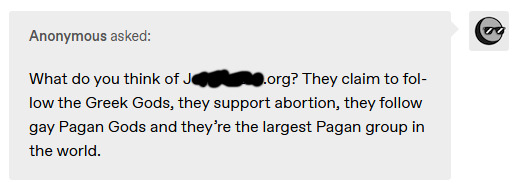
LOL, you shitheads again? You must really love getting your asses kicked if you're coming to me, of all people.
For anybody unaware, the Satanists behind the website mentioned in this ask are a bunch of openly antisemitic conspiracy theorists appropriating Eastern traditions, and they've been trying to advertise themselves and increase their SEO by sending asks like these. Each ask is tailored to appeal to whatever they think your beliefs might be, but they all follow a similar template that goes something like:
What do you think of [URL redacted]? They claim to follow [insert gods here], they [something about supporting abortion], and they're the largest [insert group here] group in the world."
The spirituality promoted on this website is rooted in deeply antisemitic conspiracy theories and pseudohistory. If I addressed every single claim they made, I'd be here all day, so I'm going to stick to a few examples:
They claim that Satanism isn't a reaction to Christianity, but is in fact older than Christianity. This is straight-up pseudohistorical bullshit.
They claim that Jews have perpetrated a grand conspiracy to conceal true spiritual knowledge from the masses. They outright cite The Protocols of the Learned Elders of Zion, a Czarist hoax created to justify violence against Russian Jews in the late 19th century. They claim that Christianity is a Jewish tool of world domination and mind control.
They claim that "Jewish ritual murder" is a thing. This is blood libel, an old conspiracy theory used to demonize Jews.
They claim that Jesus was a fictional creation made out of tropes "stolen" from various pagan gods. There is no actual evidence for this; it's another conspiracy theory. For a scholarly look at what most probably happened, I recommend How Jesus Became God: The Exaltation of a Jewish Preacher from Galilee by Bart D. Erhman. Or if you can't get your hands on the books, just look into Dr. Ehrman's videos/lectures on the topic on YouTube.
They push the extremely racist ancient aliens bullshit, claiming that the pagan gods were actually aliens.
They claim that the serpent actually represents human DNA, life force, and kundalini. This is a conspiracy theory that disregards the diversity of lore about serpents in various belief systems and traditions around the world, and culturally appropriates from Eastern traditions.
Their idea of what constitutes genuine Satanic practices is basically New Agers' bastardized versions of Eastern concepts and practices.
They claim that the "Tree of Life" is actually a stolen pagan symbol that maps the human soul. Again, an unsubstantiated conspiracy theory that disregards the actual significance of trees within the various traditions that involve them.
They claim that the Pentateuch was ripped off from the five suits of the tarot, and that tarot has ancient origins with alchemical significance. Tarot was actually invented in the 15th century for playing games. Mystical symbolism was applied by occultists in the 18th century.
The creators of the site apparently believe that the Simon Necronomicon is a genuine translation of older documents. It's not. The Necronomicon was a literary device created by HP Lovecraft; every text purporting to be a translation of the Necronomicon is a modern creation.
If you get an anon message like this in your inbox, do not post it. These people want you to share their URL to get more publicity and spread their antisemitic conspirituality. Don't give them what they want.
#answered#antisemitism#conspirituality#satanism#satanists#conspiracy theories#conspiracy theory#conspiracism#witchblr#paganblr#occultblr#racism
307 notes
·
View notes
Text
10 Ways to End a Prayer Aside from Saying Amen
Note: these are just ideas based on something I struggled with when I was a newbie pagan. I by no means am saying you can't use the word "amen", I'm just trying to help those who may not want to! If something works-- then it works!
Being raised in a very hard-core Christian household I was always taught to end my prayers with the phrase "Amen", but when I realized the faith didn't really fit me... I found that using that phrase didn't really fit me either! So, what could you say in place of it? Here are some ideas! Some I came up with, some I scoured the internet to find!
"THE END"
I have two younger siblings and they both used to say 'the end' all of the time because they thought when we said 'amen' we were actually saying that. It's very direct, but I suppose it works!
"AS IT IS REQUIRED" / "AS YOU REQUIRE"
I also use this phrasing in place of "so mote it be" when I do spellwork, not because it's a bad phrase, but mainly because I'm the type of person who has to vibe with the words I utilize. (I'm sorry I'm insufferable lol). I've used it at the end of prayers and it's nice and to the point without being too crass sounding.
"AND SO IT IS"
This one always reminds me of manifestation. Kind of a "I will obtain xyz" mindset. Sometimes I use it if I'm praying for help when I'm working towards a goal.
" DONE "
The first couple of times I tried praying without using the word "amen" I got lost on what to say, so I very awkwardly just said done and went about my day. It might work for you, but it definitely felt weird for me!
"AND SO IT IS, AND IT ALWAYS WILL BE"
I've used this phrase quite a bit and I currently like it a lot. I mainly use it when I'm doing prayers to show my admiration for my deities, or when I'm doing prayers for special occasions. I came up with it while writing some poems this Beltane and it kinda just stuck!
" LET IT BE SO " / "SO BE IT" / "VERILY" / "TRULY"
According to wikipedia, these are all translations of the word amen? So I suppose you could find a way to use them!
"BLESSED BE"
I'm gonna be honest, I lurked on some reddit forums for ideas and this one came up A LOT. I've only ever really thought of this phrase as being a form of "goodbye", and I didn't realize you could end a prayer with this!
"THANK YOU"
Sometimes the best way to end something is just a simple "thanks for listening".
UTILIZING ANOTHER LANGUAGE
If you feel so inclined, finding a language that suits you and your practice and looking for a similar meaning to 'amen' might be helpful to you!
POP CULTURE / LITERATURE
This may sound weird, but I saw a few people talking about using "This is the way" from the Mandelorian, and I even saw someone who recommended using "as you wish" from the princess bride! I also saw a suggestion where someone took a phrase from an Old English text and utilized it! The world is your oyster!
So there's a teeny list to get you started! As always I'd love if people would reblog with their own ideas and alternatives!
Online sources I looked at:
#paganism#pagan#paganblr#celtic pagan#pagans of tumblr#beginner pagan#pagan tips#celtic paganism#pagan witch#hellenic paganism#norse paganism#kemetic paganism
122 notes
·
View notes
Text
European history is not white


Someone commented this to a post I reblogged, which message is basically "we shouldn't venerate the Dead White Man HistoryTM and we should elevate other history too, but we still need to learn Dead White Man HistoryTM to understand the world today". It's basically a response to the attitude you sometimes come across in the internet that sees learning about those Dead White MenTM as not worth our time. And this person, who seems to be following this blog because they responded to my reblog, takes it as a personal attack against all white Europeans. For some reason. Well I take these comments as a personal attack against historical understanding.
Firstly, the post clearly didn't say you shouldn't venerate any European history, because not all European history is Dead White Man HistoryTM. Obviously this person thinks European history is white, which is not true, but surely, surely, they know it's not all men? Secondly, what is "west culture"? When did it start? There is not one western culture, not one European culture. The first concept of some shared Europeanness was the Christendom in Middle Ages, but it was not exactly the same as we think of Europe today, because it did not include the pagan areas, but it included a lot of Levant and parts of Central Asia, where there were large Christian areas. And Europe was not "very white" nor was the Christendom. The more modern concept of West was cooked in tandem with race and whiteness during colonial era and Enlightenment, around 17th to 18th centuries. And Europe was certainly not very white then. The western world also includes a lot of colonized areas, so that's obviously not white history. Thirdly, implying that asking white people to apologize for European history (which no one did ask) is as ridiculous as asking black people for African history is... a choice. Black people do exist in a lot of other places than Africa, which white people should be the ones apologizing for, and really white people also have a lot to answer for about African history. Lastly, if you think the quote "anyone who thinks those dead white guys are aspirational is a white supremacist" means you as an European are demanded to apologize for your existence, maybe - as we say in Finland - that dog yelps, which the stick clanks. (I'm sorry I think I'm the funniest person in the world when I poorly translate Finnish sayings into English.)
The thing is, there is no point in European history, when Europe was white, for three reasons. 1) Whiteness was invented in 17th century and is an arbitrary concept that has changed it's meaning through time. 2) Whichever standard you use, historical or current, Europe still has never been all or overwhelmingly white, because whiteness is defined as the in-group of colonialists, and there has always been the internal Other too. In fact the racial hierarchy requires an internal Other. 3) People have always moved around a lot. The Eurasian steppe and the Mediterranean Sea have always been very important routes of migration and trade. I've been meaning to make a post proving exactly that to people like this, since as I've gathered my collection of primary images of clothing, I've also gathered quite a lot of European primary images showing non-white people, so I will use this opportunity to write that post.
So let's start from the beginning. Were the original inhabitants of Europe white? Of course not. The original humans had dark skin so obviously first Europeans had dark skin. Whenever new DNA evidence of dark skinned early Europeans come out (like this study), the inevitable right-wing backlash that follows is so interesting to me. Like what did you think? Do you still believe the racist 17th century theories that white people and people of colour are literally different species? I'm sure these people will implode when they learn that studies (e.g. this) suggest in fact only 10 000 years ago Europeans had dark skin, and even just 5 000 years ago, when Egypt (an many others) was already doing it's civilization thing, Europeans had brown skin (another source). According to the widely accepted theory, around that time 5 000 years ago the Proto-Indo-European language developed in the Pontic-Caspian steppe, which extends from Eastern Europe to Central Asia. These Proto-Indo-Europeans first migrated to Anatolia and then to Europe and Asia. Were they white? Well, they were probably not light skinned (probably had brown skin like the other people living in Europe around that time), the Asian branch of Indo-European peoples (Persians, most Afghans, Bengalis, most Indians, etc.) are certainly not considered white today and a lot of the people today living in that area are Turkic and Mongolic people, who are also not considered white. I think this highlights how nonsensical the concept of race is, but I don't think Proto-Indo-Europeans would have been considered white with any standard.
Around Bronze Age light skin became common among the people in Europe, while in East Asia it had become wide spread earlier. This does not however mark the point when "Europe became white". During the Bronze Age there was a lot of migration back and forth in the Eurasian steppe, and the early civilizations around Mediterranean did a lot of trade between Europe, Africa and Asia, which always means also people settling in different places to establish trading posts and intermarrying. There were several imperial powers that also stretched to multiple continents, like the briefly lived Macedonian Empire that stretched from Greece to Himalayas and Phoenicians from Levant, who didn't built an empire but settled in North Africa, Sicily and Iberia. In Iron Age the Carthaginian Empire, descendants of Phoenician settlers in current Tunisia, build an Empire that spanned most of the western Mediterranean coast. Their army occupying that area included among others Italic people, Gauls, Britons, Greeks and Amazigh people.
Iron Age also of course saw the rise of the Roman Republic, and later empire, but it was preceded by Etruscans, who populated Tuscan, and possibly preceded the Indo-European presence. However, weather through trade and migration with other Mediterraneans or the continuing presence of darker skin tones of the early Europeans, their art quite often depicts darker skin tones too, like seen below in first two images. Roman Empire at it's height spanned from Babylonia to the British Isles. They recruited soldiers from all provinces and intentionally used stationed them in different areas so they wouldn't be too sympathetic to possible rebels or neighboring enemies. Historical sources mention black Nubian soldiers in British Isles for example. They also built a lot of infrastructure around the empire to ensure protection and easy transportation through trade routes inside the empire. During this time Jewish groups also migrated from Levant to both North-Africa and Europe. Rome even had non-European emperors, like Septimius Severus who originated from Levant and was Punic (descendants of Phoenicians) from his father's side, and who was depicted with darker skin (third picture below). Various ethnicities with differing skin tones are represented all over Roman art, like in the fourth picture below from hunting lodge in Sicily.

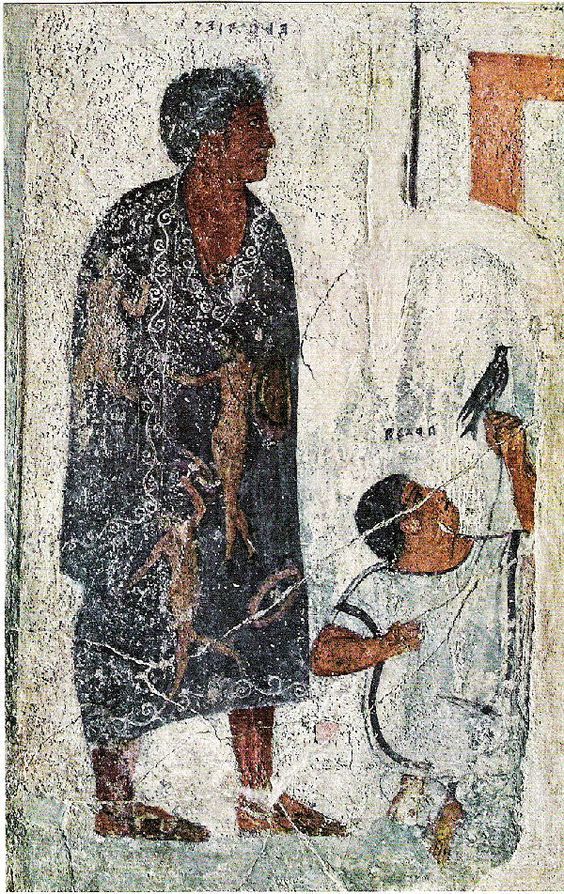


Eurasian steppe continued to be important source of migration and trade between Europe and Asia. Scythians, Iranic nomadic people, were important for facilitating the trade between East Asia and Europe through the silk road during the Iron Age. They controlled large parts of Eastern Europe ruling over Slavic people and later assimilating to the various Slavic groups after loosing their political standing. Other Iranic steppe nomads, connected to Scythian culture also populated the Eurasian steppe during and after Scythia. During the Migration Period, which happened around and after the time of Western Rome, even more different groups migrated to Europe through the steppe. Huns arrived from east to the Volga region by mid-4th century, and they likely came from the eastern parts of the steppe from Mongolian area. Their origins are unclear and they were either Mongolic, Turkic or Iranic origin, possibly some mix of them. Primary descriptions of them suggests facial features common in East Asia. They were possibly the nomadic steppe people known as Xiongnu in China, which was significant in East and Central Asia from 3rd century BCE to 2nd century CE until they moved towards west. Between 4th and 6th centuries they dominated Eastern and Central Europe and raided Roman Empire contributing to the fall of Western Rome.
After disintegration of the Hun Empire, the Huns assimilated likely to the Turkic arrivals of the second wave of the Migration Period. Turkic people originate likely in southern Siberia and in later Migration period they controlled much of the Eurasian steppe and migrated to Eastern Europe too. A Turkic Avar Khagenate (nation led by a khan) controlled much of Eastern Europe from 6th to 8th century until they were assimilated to the conquering Franks and Bulgars (another Turkic people). The Bulgars established the Bulgarian Empire, which lasted from 7th to 11th in the Balkans. The Bulgars eventually adopted the language and culture of the local Southern Slavic people. The second wave of Migration Period also saw the Moor conquest of Iberia and Sicily. Moors were not a single ethnic group but Arab and various Amazigh Muslims. Their presence in the Iberian peninsula lasted from 8th to 15th century and they controlled Sicily from 9th to 11th century until the Norman conquest. During the Norman rule though, the various religious and ethnic groups (which also included Greeks and Italic people) continued to live in relative harmony and the North-African Muslim presence continued till 13th century. Let's be clear that the Northern Europe was also not white. Vikings also got their hands into the second wave migration action and traveled widely to east and west. Viking crews were not exclusively Scandinavians, but recruited along their travels various other people, as DNA evidence proves. They also traded with Byzantium (when they weren't raiding it) and Turkic people, intermarried and bought slaves, some of which were not white or European. A Muslim traveler even wrote one of the most important accounts of Vikings when encountering them in Volga.
By this point it should already be clear that Medieval Europe was neither white, but there's more. Romani people, who originate from India and speak Indo-Aryan language, arrived around 12th century to Balkans. They continued to migrate through Europe, by 14th century they were in Italy, by 15th century in Germany and by 16h century in Britain and Sweden. Another wave of Romani migration from Persia through North-Africa, arrived in Europe around 15th century. Then there's the Mongol Empire. In 13th century they ruled very briefly a massive portion of the whole Eurasian continent, including the Eastern Europe. After reaching it's largest extent, it quickly disintegrated. The Eurasian Steppe became the Golden Horde, but lost most of the Eastern-Europe, except Pontic-Caspian Steppe. They ruled over Slavs, Circissians, Turkic groups and Finno-Ugric groups till early 15th century. The Mongolian rulers assimilated to the Turkic people, who had been the previous rulers in most of the steppe. These Turkic people of the Golden Horde came to be known as Tatars. Golden Horde eventually split into several Tatar khagenates in 15th century, when the khagenates, except the Crimean Khagenate, were conquered by the Tsardom of Moscovy. Crimean Khagenate was annexed by the Russian Empire in 1783. Crusades were a movement from Europe to Levant, but they also meant intermarriage in the the Crusader kingdoms especially between the European and Levant Christians, and some movement back and froth between these kingdoms and Europe, trade and a lot of movement back after the Crusader kingdoms were defeated in 13th century. Generally too trade across the Mediterranean sea was extensive and led to migration and intermarriage.
And here's some example of people of colour in Medieval European art, shown as part of the majority white European societies. First is from a 15th century French manuscript depicting Burgundy court with dark skin courtier and lady in waiting. Second one is from a Flemish manuscript from 15th century of courtiers, including a black courtier, going for a hunt. Third is a 15th century Venetian gondolier with dark skin.

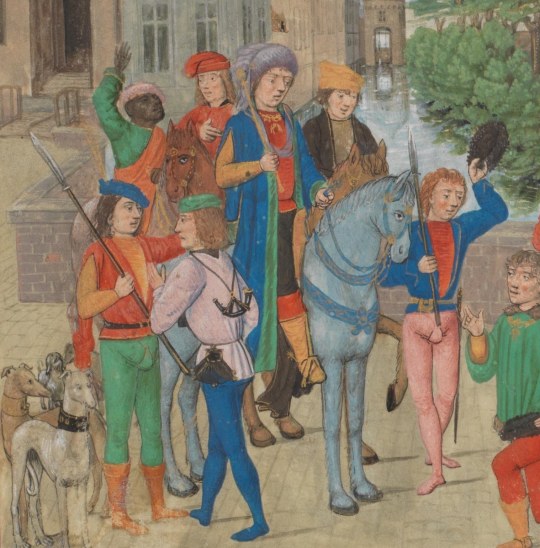

In Renaissance Era Europe was only increasing it's trade and therefore had even more connections outside Europe. The first picture below is Lisbon, which had strong trade relationship with Africa, depicted in late 16th century. People with darker skin tones were part all classes. Second image is an Italian portrait of probably a seamstress from 16th century. Third one is a portrait of one of the personal guards of the Holy Roman Emperor. Fourth image is a portrait of Alessandro de' Medici, duke of Florence, who was noted for his brown complexion, and the modern scholarly theory is that his mother was a (likely brown) Italian peasant woman.
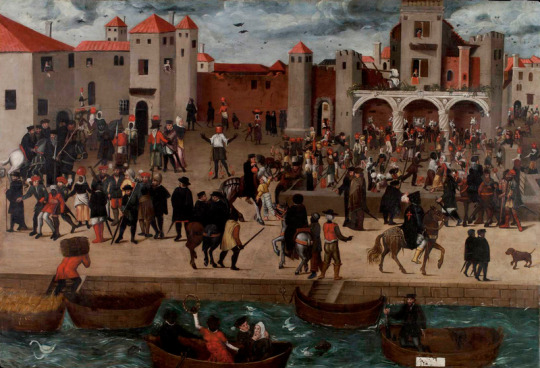

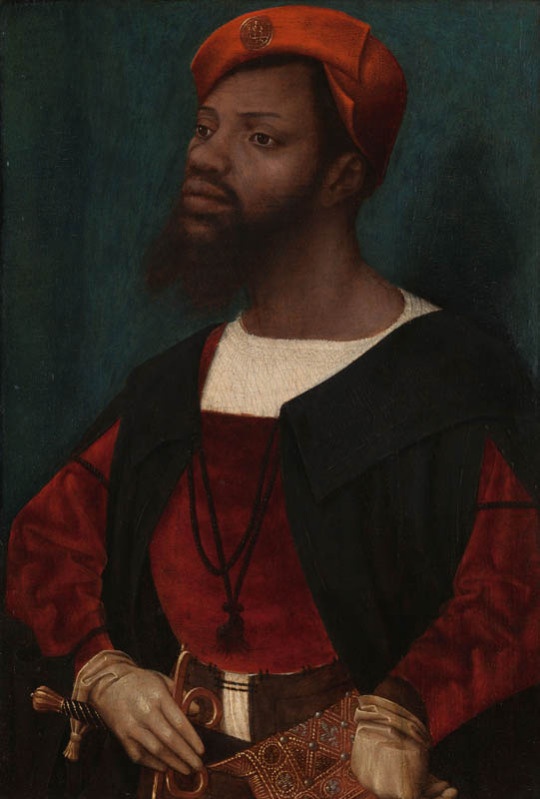

Colonialism begun in the Renaissance Era, but the wide spread colonial extraction and slavery really got going in the 17th century. Racial hierarchy was developed initially to justify the trans-Atlantic slave trade specifically. That's why the early racial essentialism was mostly focused on establishing differences between white Europeans and black Africans. Whiteness was the default, many theories believed humans were originally white and non-whites "degenerated" either through their lives (some believed dark skin was basically a tan or a desease and that everyone was born white) or through history. Originally white people included West-Asians, some Central-Asians, some North-Africans and even sometimes Indigenous Americans in addition to Europeans. The category of white inevitably shrank as more justifications for atrocities of the ever expanding colonial exploitation were required. The colonial exploitation facilitated development of capitalism and the industrial revolution, which led to extreme class inequality and worsening poverty in the European colonial powers. This eventually became an issue for the beneficiaries of colonialism as worker movements and socialism were suddenly very appealing to the working class.
So what did the ruling classes do? Shrink whiteness and give white working classes and middle classes justifications to oppress others. Jews and Roma people had long been common scapegoats and targets of oppression. Their oppression was updated to the modern era and racial categories were built for that purpose. The colonial powers had practiced in their own neighborhoods before starting their colonial projects in earnest and many of those European proto-colonies were developed to the modern colonial model and justified the same way. In 19th century, when racial pseudoscience was reaching it's peak, Slavs, others in Balkan, the Irish (more broadly Celts), Sámi (who had lost their white card very early), Finns, Southern Italians, the Spanish, the Southern French and Greeks all were considered at least not fully white. The Southern Europeans and many Slavs were not even colonized (at least in the modern sense, though with some cases like Greeks it's more complicated than that), but they looked too much and were culturally too similar to other non-white Mediterraneans, and they were generally quite poor. In many of these cases, like Italians, the French and Slavs, it was primarily others belonging in the same group, who were making them into second class citizens. All this is to highlight how very malleable the concept of race is and that it's not at all easy to define the race of historical people.
However, even if we would go with the racial categories of today, Europe was still far from being all white in this period. You had Roma, who certainly are not included in whiteness today, and European Jews, whose whiteness is very conditional, descendants of Moors in Southern Europe and Tatars and Turks in Eastern Europe and Turkey, which today is often not thought of as part of Europe, but historically certainly was. And then colonialism brought even more people into Europe forcibly, in search of work because their home was destroyed or for diplomatic and business reasons. There were then even more people of colour, but they were more segregated from the white society. Black slaves and servants are very much represented in European art from 17th century onward, but these were not the only roles non-white people in Europe were in, which I will use these examples to show. First is a Flemish portrait of Congo's Emissary, Dom Miguel de Castro, 1643. Second is a 1650 portrait of a Moorish Spanish man Juan de Pareja, who was enslaved by the artist as artisanal assistant, but was freed and became a successful artist himself. Third is a 1768 portrait of Ignatius Sancho, a British-African writer and abolitionist, who had escaped slavery as a 20-year-old. Fourth painting is from 1778 of Dido Elizabeth Belle, a British gentlewoman born to a slave mother who was recognized as a legitimate daughter by her father, and her cousin. The fifth portrait is of an unknown woman by (probably) a Swiss painter from late 18th century. Sixth is a 1760s Italian portrait of a young black man.

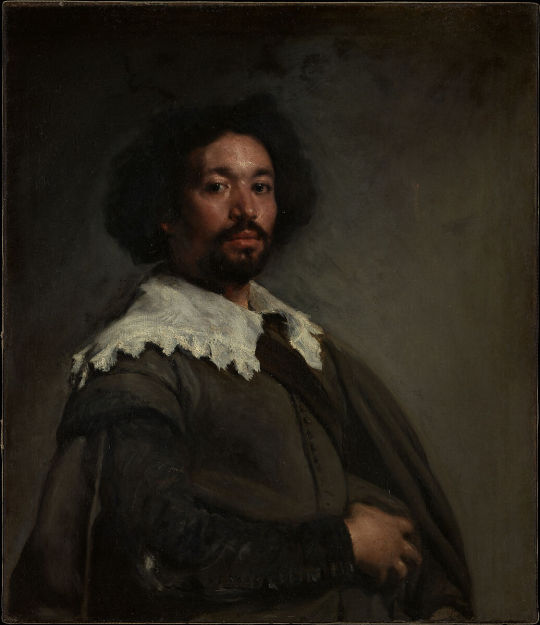
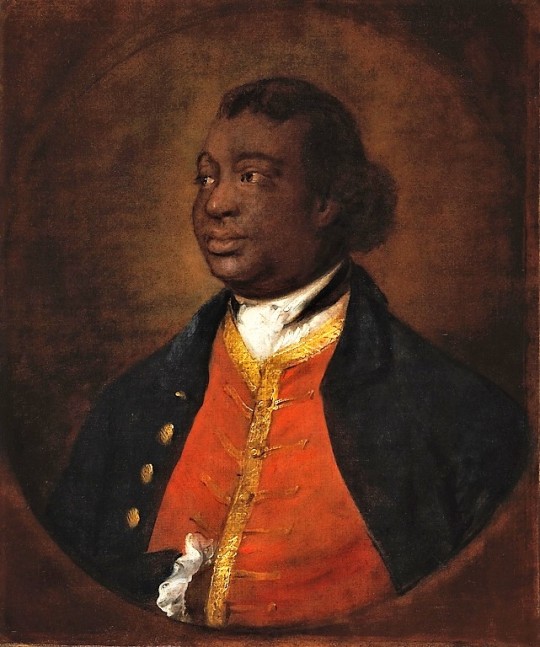
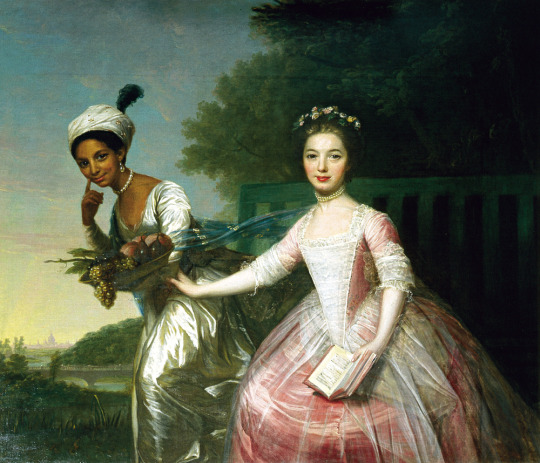
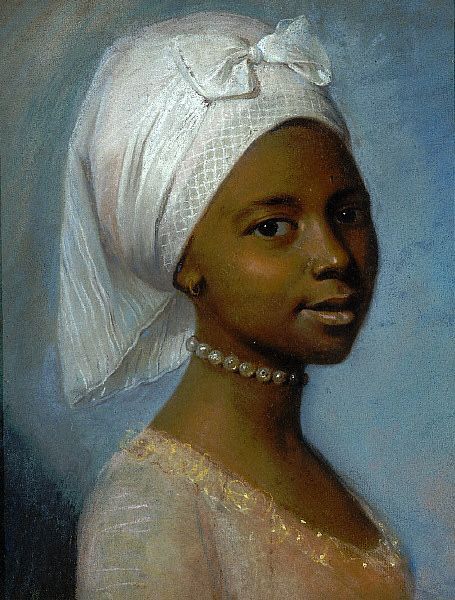
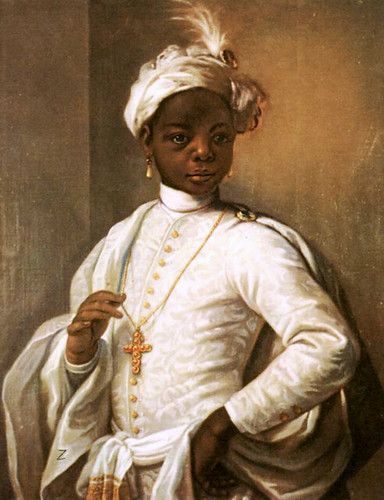
In late 18th century England abolished slavery in British Isles first, then in early 19th century in the whole British Empire, thanks to the continuous campaign of free Black people and some white allies, notably Quakers. Around the same time slavery was abolished in France (briefly till Napoleon got to power) after the French revolution. This meant there were a lot more free black people in Europe after that. In 18th century the Europeans, British especially, were colonizing Asia as much they could, which meant that in 19th century there started to also be a lot more Asian, especially Indian people in Europe. First picture below is of Thomas Alexander Dumas, who was son of a black slave woman and a white noble French man and became a general in the French revolutionary army. His son was one of the most well-known French authors, Alexander Dumas, who wrote The Count of Monte Cristo and The Three Musketeers. Second portrait is of Jean-Baptiste Belley, a Senegalese former slave, who became French revolutionary politician. Third portrait is from 1810 of Dean Mahomed, an Indian-British entrepreneur, who established the first Indian restaurant in London. Forth is Arab-Javanese Romantic painter Saleh Syarif Bustaman, who spend years in Europe. Fifth is a 1862 photo of Sara Forbes Bonnetta, originally named Aina, princess of Edbago clan of Yoruba, who was captured into slavery as a child, but later freed and made Queen Victoria's ward and goddaughter. She married a Nigerian businessman, naval officer and statesman, James Pinson Labulo Davies (sixth picture).
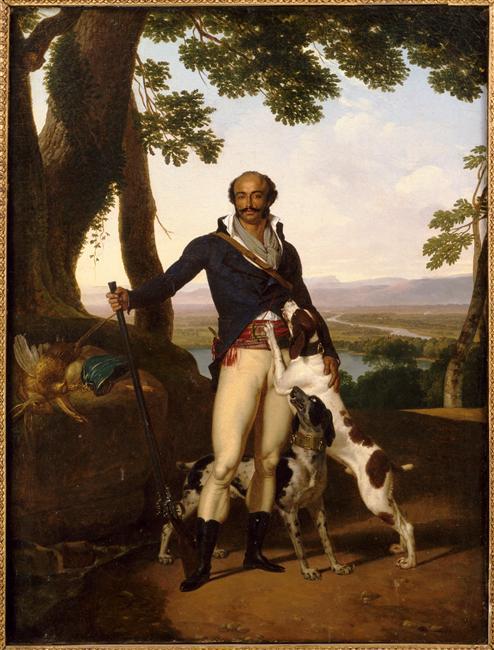


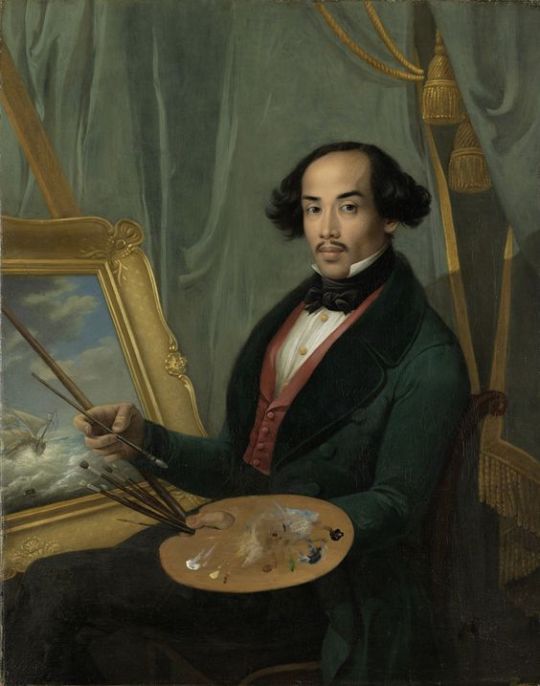
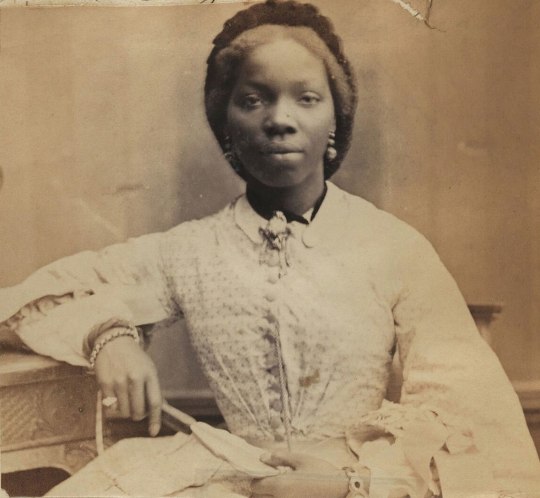
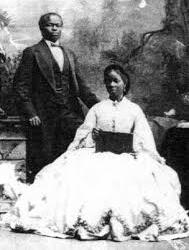
So any guesses on at what point was that "very white Europe" when the "west culture" begun? It kinda seems to me that it never actually existed.
#history#poc history#black history#historical art#european history#history of race#colonialism#racism#slavery#painting#photograph
174 notes
·
View notes
Text
Why are we, as theistic people, allowing ourselves to speak out against other religions as a whole? I’ve seen on this website so much bias and negativity against Christianity and Christians in particular. While we can all agree that authoritarian religious institutions must absolutely be opposed, we’ve no right to determine that this or that religion is inherently bad. Especially considering that even within Christianity, countless practitioners are affiliated with no such institution. Feel free to disagree with me, but this is something I’ll absolutely never budge on. No religion is inherently bad. This sort of discourse is widely spread by the type of anti-religion people who can only take into account their own personal thoughts, and who won’t acknowledge the immense rift between religion and cult. The idea that a religion is “inherently” this or that is exactly as harmful as the idea that certain cultures have inherent faults. Let us not, as pagans, try to argue against religions we do not practice ourselves. Religious people of all faiths have much in common, and it serves no one to try and prove that one’s faith is somehow “better” than the other. In my opinion, this respect should go both ways. And it’s crucial that one try to see beyond what they’ve personally experienced and to put oneself in other people’s shoes. After all, the very act of believing in the divine often relies on things one hasn’t personally experienced. By choosing to speak out against a religion by trying to prove its supposed inherent flaws, one disregards the diversity of practice that characterize every single form of spirituality in our world. Religions as widespread as Christianity or Judaism are practiced in so many vastly different ways that it would simply be impossible to lump every practitioner together without leaving out essential qualities of their religious demographic. I’ll repeat this for what feels like the billionth time this year, let us respect other faiths as we want to be respected.
172 notes
·
View notes
Note
Hey-o! Tis the season for people to talk about how the holidays were "actually pagan" and I'm on the hunt for sources about how that's really not the case, if you have any you'd recommend!
Okay, so the problem is there are so many weird "Christmas is stolen!" bullshit memes going around, it's so hard to just give you a comprehensive list of sources. Christmas celebrations have evolved as the religion has spread, and different things come from different times...
The key here is to go for academic sources. This is a question of history, and a well supported historical research is going to tell you whether they're operating from primary, secondary or tertiary sources.
So while I can't give you a simple list, let me give you a couple of examples off the top of my head and give you tips on how to investigate any the dumb claims that get passed around.
Christmas being in December: So a lot of people go for the "Christmas is in December so it can steal from [INSERT SOLSTICE CELBRATION]" is ahistorical... because we know exactly why Christmas is in December. Because the guys who made the decision argued with each other and left behind written documentation. The two big names you need to look up are Clement of Alexandria (who pitched January 6th) and Hippolytus of Rome (who proposed December 25th). This is around the turn of the third century, and you can find both of their writings. Some folks have questioned the authenticity of some of Hippolytus of Rome's writings, but Clement of Alexandria's seem well supported. These were internal arguments about when the birth of Christ took place within the early church, and when they settled on late December. There are reasons for this, and you can read their arguments (it largely has to do with the importance of when Jesus was conceived -- they wanted that to be an important date and then added nine months to it). Importantly though, because linear time is a thing, this means Christmas was set in December before the Christianization of the Germanic and Norse tribes... so anyone who says Christmas was set to December to correspond with Yule doesn't understand the concept of "coincidences."
The Christmas Tree: The Christmas tree was invented in 16th century Germany. That's... that's just written down all over the place. Now, there are legends about Martin Luther being the first who did it -- but I'm pretty certain that's just an embellishment that got added on. There are preceding traditions where part of an evergreen was brought into the home as a part of solstice traditions (though some will claim the Egyptians did this? Which is wild -- likely misinterpreting their use of palm fronds as the same thing), but the act of taking a whole ass tree, cutting it down, putting it in your house, and decorating it? That's 16th century Germany all the way. You can rabbit hole so many sources on that one, but honestly just pick apart the citations on the Wikipedia page. Putting a branch in your house and dragging a whole tree in are very different acts.
Jesus's story is copied from [INSERT RANDOM GOD]: There are so many of these, and some are just downright disrespectful to major world religions (the Krishna version of the meme especially). The answer is... just see if what the meme is saying about the god is supported by the mythology. Like I've seen ones that says Dionysus was "born of a virgin." If you know anything about the Greek gods, you're probably already laughing on the floor. Horus gets dragged into this too, because Gerald Massey was trying to pull a "White Goddess but with Dudes." But any serious research on Horus will tell you the supposed parallels aren't supported by the mythology.
So sorry, this wasn't so much sources you can use as it is how to look for them to begin with. Because there's just so, so much. This isn't even covering cases of syncretism, where pre-existing cultural traditions got continued post-Christianization. Because it's almost always the case that if a pre-Christian practice endured post Christianization, it's because people decided to keep doing it -- not because the church was trying to "steal" it. The latter means there was some mustache twirling plan behind it, when the former means (usually) the church went "Well, they're paying their tithes and saying it's for Jesus, so who gives a shit?"
I'm just going to finish this off with linking to my podcast episode on this, along with Ocean Keltoi's great Yule video on the topic. Hopefully that helps.
youtube
187 notes
·
View notes
Text
astro notes: the sun 🌞
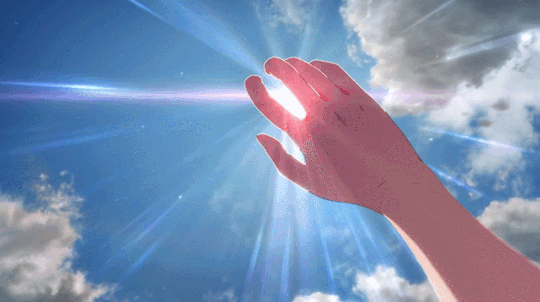
The Sun represents the central principle of vital energy and conscious selfhood in the birth chart. Just as the Sun is the central entity in the solar system, it is also the central entity in the individual psyche reflected in the birth chart. Your Sun sign is considered the core of who you are in astrology. It represents your vitality, your sense of self, and your individuality. The Sun in your birth chart symbolizes your spirit, inspirations, motivations, personality, expressions, life force, and personal identity. The sign the Sun sits within on the day of your birth shows how this life force expresses itself in the world and what traits you are building throughout your life to feel and become more of yourself.
The Sun represents spiritual intelligence. Light is a symbol of intelligence or an awakening, and the Sun, as the supreme source of light in the human world, represents the highest form of intelligence, spiritual intelligence. The Sun symbolizes the Creator in various spiritual traditions, with prophets and messengers acting as mirrors, reflecting the sun's rays. This concept is central to progressive revelation, the belief that the universal God continually sends guidance to humanity through different prophets, all reflecting the same divine light.
In Japan, the Sun is revered as a goddess, the personification of the physical sun and the Ruler of Heaven. The Japanese Sun-goddess, Amaterasu, is considered the founder of Japan, and all emperors are known as "Sons of the Sun." In Shinto, the ancient religion of Japan, nature is worshipped, and the Sun plays a central role in rituals and customs. The Sun is seen as a source of physical stamina, business success, and protection from invasion.
In Christianity, the Sun has been used metaphorically to represent Christ. Christ is often referred to as the "Sun of Righteousness," and his birth was symbolically linked to the sun's creation in early Christian literature. The winter solstice, December 25, was chosen for Christmas because of its association with the invincible sun in pagan celebrations.
In ancient Greek art, the sun symbolized eternity and stability, despite the constant flux of time. The sun god Helios was worshipped in the Seleucid east, with bronze coins depicting a fusion of Helios and Apollo. The Vergina Sun, a rayed solar symbol, represented completeness and totality, symbolizing the 12 gods and the four elements.
In Native American traditions, the Sun is revered as a living being, connected to all aspects of nature. Native to the Americas understood themselves to be part of a larger interconnected web of life, where everything is sacred and connected. The Sun is viewed as essential for life, providing warmth, light, and energy to sustain all living beings.
The Sun holds immense significance across various cultures and spiritual traditions. It represents the core of who you are, your vitality, and your sense of self. Spiritually, it symbolizes the highest form of intelligence and the source of all light.
The Sun's symbolism reflects its universal importance as a life-giving force that sustains all living beings. Whether as a celestial body in astrology, a goddess in Japanese mythology, a metaphor for Christ in Christianity, or a symbol of stability in ancient Greek art, the Sun's significance transcends cultural boundaries, reminding us of our interconnectedness with the cosmos and the natural world.
follow for more astro insights like this and support me over on instagram @sensualnoire or yt @quenysefields
#sun#the sun#astrologer#astrology#astro observations#astro notes#astro community#astro#astrology observations#astro blog#astro placements#astro posts#astroblr#astrology chart#astrology fyp#astrology notes#astrology readings#astrology signs#astronotes#astro stuff#the sun in astrology#spirituality#intellect#warmth#life#black tumblr#gemini#mpls#aries#taurus
121 notes
·
View notes
Text
Okay I’m going to say it because I’ve seen like 10 posts about this in the last week and it’s kind of aggravating.
Before you start practicing paganism or dual faith or anything of any kind PLEASE PLEASE PLEASE learn the meaning and history of Syncretism. PLEASE.
Please stop saying that Christmas is only a Christian holiday, please stop saying that Christmas was stollen from the pagans. Please stop insisting that Yule and Christmas are the same holiday! Please stop saying that pagans cannot celebrate Christmas or that Christians shouldn’t celebrate Christmas! Christmas is many things to many different groups of people and ideas and customs evolve through time!!! There is NUANCE to these very complex ideas!!! Christmas does not need to be reclaimed, please stop.
Please stop saying that it belongs or doesn’t belong to any given group especially when humanity is so prone to spread messages and customs amongst eachother!!! “Similar” does not equal “the same” and different does not equal “the enemy”. Please stop trying to create these illogical divisions where they do not exist!!! Please read about the history of faith !!!! I beg of you!!!!
So often we see the blending and unity of concepts as “appropriation” and I’m sick of it. Our beliefs connect us so much more than they divide us. We learn so much about the world from each other and our different interpretations.
Likewise, just to touch base- nearly every single mythology or faith in the entire world takes its inspirations from somewhere. You are no superior to a Christian because you think your faith and customs are “older”.
We live in a paradoxical universe where multiple things can be true at once. You DO NOT get the authority to tell a Christian that their God is XYZ just because you’re a pagan. You do not get the authority to redefine how a group of people sees and interacts with their personal name of God. And you by no means get to claim credit for how different cultures interpret the natural world.
Yes, Christians obviously have a lot of practices that mirror pagan ones, they are not pagan, do not call them pagan. I don’t care how you feel about the Abrahamic God. So many of us hold a deep resentment towards Christianity because of religious trauma and I completely understand that, but when you try to massively oversimplify such complex topics like religion and faith, you not only risk sounding like an asshole but you make yourself look straight up stupid because you’re just wrong.
I am a devotee of Lucifer and I believe him to be the divine masculine aspect of mother Venus. I still need to understand and respect that for Christians, Lucifer represents something entirely different and that’s okay. They’re not necessarily wrong even if I fundamentally disagree. I disagree with what Lucifer is among other Luciferians and Satanists. That’s OKAY.
We have GOT to stop talking about mythology and folklore so literally. It leads us to have this “one or the other” mentality when more than one thing can be true at once! These myths are flexible and meant to change with culture. We can have respectful debates and conversations but holy moly please stop insisting that Christianity has “stollen” from you, and please for the love of God please stop trying to ruin a day that is significant to them by telling every Christian you see that Christmas is actually a pagan holiday.
(- and when I say this I am not referring to the atrocities of assimilation and slavery that forced pagan cultures to become Christian/catholic due to racism and xenophobia, that’s obviously very bad. My argument is simply that the entire Christian/Jewish/ Muslim faith cannot be discounted simply because historically, bad people used it to do bad things).
Thank you. 🙏
#witchcraft#magick#occultism#witch community#demonology#pagan#paganism#witch aesthetic#witchblr#grimoire#paganblr#pagan witch#pagan blog#pagan community#pagans of tumblr#eclectic#luciferian witch#theistic luciferianism#polytheistic#deity witchcraft#deity work
101 notes
·
View notes
Photo

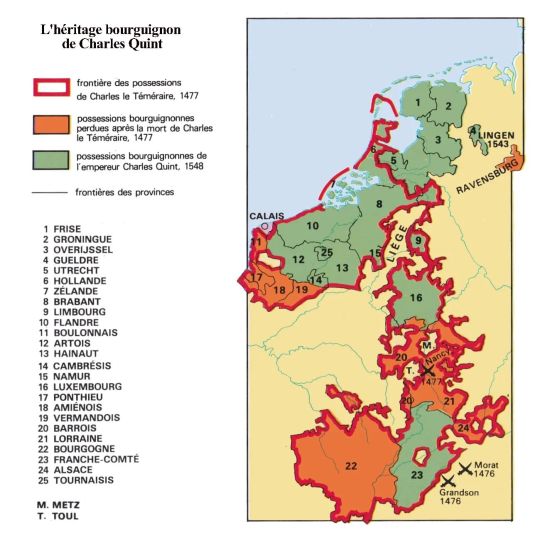
The Empire of Charles V
« Le grand atlas de l’histoire mondiale », Encyclopædia Universalis, 1979
by cartesdhistoire
Charles of Habsburg was a Burgundian duke who became king of Spain in 1516 and later Holy Roman Emperor in 1520. During his early years, the Burgundian heritage remained the primary cultural influence on the future Charles V, who was raised in the Netherlands. However, within him, all the legacies converged: Roman and Carolingian successions, messianism, crusading duty, the reestablishment of imperial supremacy, and the fulfillment of the latter through the conquest of the New World.
The title of Charles V reflects the complexity of his personal empire while exalting its grandeur. He is commonly referred to as "Cesarea Catholica Majestas," and he often described himself in documentation as "emperor and king," succinctly expressing a dual sovereignty consolidated under one ruler.
Contrary to the fears of his contemporaries, who perceived him as possessing implacable power and harboring ambitions of conquering Europe and the world, Charles V's imperial project did not aim for such dominion. Throughout his life, the emperor defended against such aspirations, as evidenced by his actions. However, he did have a plan for his title to be more than just an honorific designation but a functional role in its own right. The individual who received the imperial crown theoretically held the highest temporal authority after God – second only to the pope – and had no earthly superior. Charles V envisioned leading humanity along the path outlined by the Gospels, even if it required war against pagans and infidels.
This was the true vision of Charles V: to unite Christians in a quest symbolized by his throne without subjugating them. While he aimed to lead Christendom, he did not intend to completely merge it with the empire he governed personally. Such an endeavor would have been burdensome for all involved and required the systematic use of force, which did not align with the emperor's character.
64 notes
·
View notes
Text
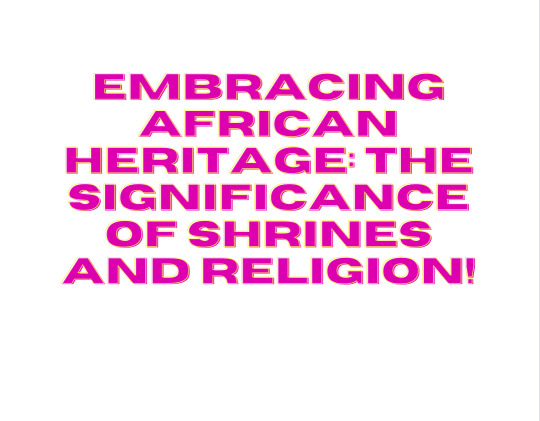
Embracing African Heritage: The Significance of Shrines and Religion

Africa, often referred to as the cradle of humanity, boasts a rich tapestry of cultures, traditions, and spiritual beliefs that have endured for millennia. Central to this heritage are the sacred shrines and profound religious practices that serve as pillars of community, identity, and connection to the divine.
Shrines, both natural and constructed, hold a special place in African spirituality. These sites are often nestled in the heart of communities or hidden within the vast landscapes of the continent. From the iconic pyramids of Egypt to the humble groves of the Yoruba in Nigeria, each shrine reflects a unique blend of history, mythology, and reverence for the ancestors.
One of the fundamental aspects of African religion is the veneration of ancestors. Ancestral shrines serve as focal points for prayers, offerings, and rituals aimed at honoring those who came before. These ancestors are believed to possess wisdom, guidance, and protection, and their spirits are invoked for blessings and assistance in times of need. In many African societies, the bond between the living and the dead is deeply cherished, with rituals and ceremonies reinforcing the interconnectedness of past, present, and future generations.
Moreover, African shrines are often associated with specific deities or spirits, each embodying different aspects of the natural world or human experience. Whether it's Oshun, the Yoruba goddess of love and fertility, or Anubis, the ancient Egyptian god of the afterlife, these divine entities are revered through elaborate ceremonies, dances, and sacrifices. Through these rituals, devotees seek communion with the divine and seek guidance in matters of health, prosperity, and spiritual growth.
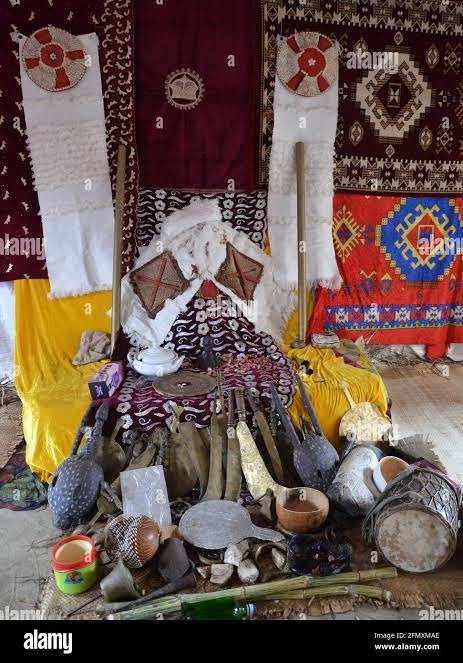
However, the significance of African shrines extends beyond the realm of spirituality. They are also repositories of cultural knowledge, oral traditions, and historical narratives passed down through generations. Within the sacred precincts of these sites, elders impart wisdom, storytellers weave tales of heroism and creation, and artists imbue their craft with symbols and motifs that speak to the essence of African identity.
Unfortunately, the colonial era and the spread of Christianity and Islam have often marginalized indigenous African religions, dismissing them as primitive or pagan. Despite this, many communities continue to uphold their traditional beliefs, adapting them to the challenges of modernity while preserving their core values and rituals. In recent years, there has been a renewed interest in African spirituality, fueled by a desire to reclaim cultural heritage and reconnect with ancestral roots.
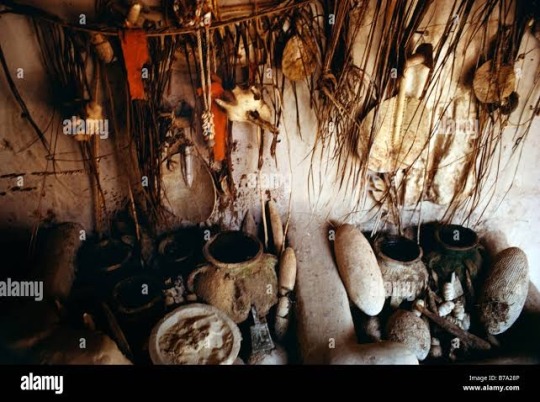
In conclusion, African shrines and religion embody the resilience, diversity, and spirituality of the continent's people. They are more than just places of worship; they are living testaments to the enduring legacy of Africa's past and the enduring power of its traditions. As we navigate an increasingly interconnected world, embracing and honoring Africa's rich heritage is not only a matter of cultural preservation but also a celebration of the human spirit's boundless capacity for faith, creativity, and reverence for the divine.
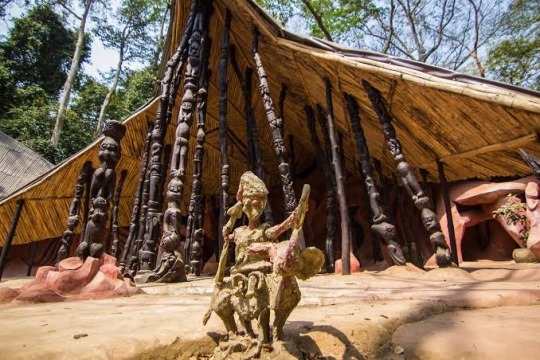
#life#animals#culture#aesthetic#black history#history#blm blacklivesmatter#anime and manga#architecture#black community
59 notes
·
View notes
Text
Stone Turtle of Karakorum, Mongolia, c. 1235-1260 CE: this statue is one of the only surviving features of Karakorum, which was once the capital city of the Mongol Empire
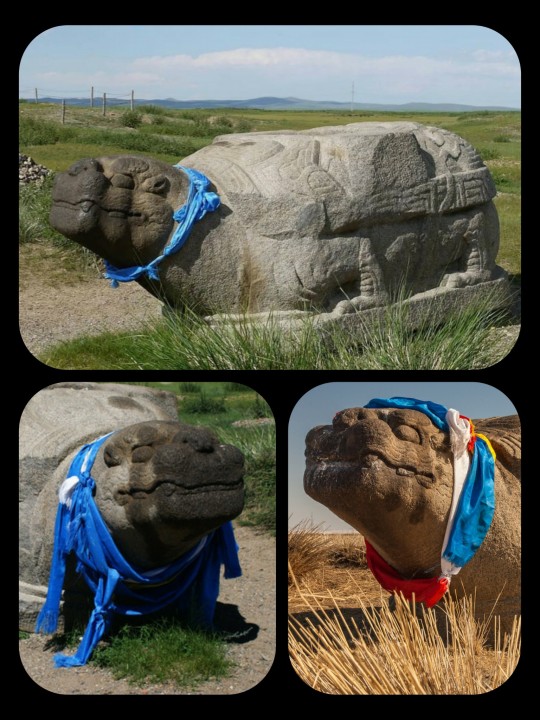
The statue is decorated with a ceremonial scarf known as a khadag (or khata), which is part of a Buddhist custom that is also found in Tibet, Nepal, and Bhutan. The scarves are often left atop shrines and sacred artifacts as a way to express respect and/or reverence. In Mongolia, this tradition also contains elements of Tengrism/shamanism.
The city of Karakorum was originally established by Genghis Khan in 1220 CE, when it was used as a base for the Mongol invasion of China. It then became the capital of the Mongol Empire in 1235 CE, and quickly developed into a thriving center for trade/cultural exchange between the Eastern and Western worlds.
The city attracted merchants of many different nationalities and faiths, and Medieval sources note that the city displayed an unusual degree of diversity and religious tolerance. It contained 12 different temples devoted to pagan and/or shamanistic traditions, two mosques, one church, and at least one Buddhist temple.
As this article explains:
The city might have been compact, but it was cosmopolitan, with residents including Mongols, Steppe tribes, Han Chinese, Persians, Armenians, and captives from Europe who included a master goldsmith from Paris named William Buchier, a woman from Metz, one Paquette, and an Englishman known only as Basil. There were, too, scribes and translators from diverse Asian nations to work in the bureaucracy, and official representatives from various foreign courts such as the Sultanates of Rum and India.
This diversity was reflected in the various religions practised there and, in time, the construction of many fine stone buildings by followers of Taoism, Buddhism, Islam, and Christianity.
The prosperous days of Karakorum were very short-lived, however. The Mongol capital was moved to Xanadu in 1263, and then to Khanbaliq (modern-day Beijing) in 1267, under the leadership of Kublai Khan; Karakorum lost most of its power, authority, and leadership in the process. Without the resources and support that it had previously received from the leaders of the Mongol Empire, the city was left in a very vulnerable position. The residents of Karakorum began leaving the site in large numbers, until the city had eventually become almost entirely abandoned.
There were a few scattered attempts to revive the city in the years that followed, but any hope of restoring Karakorum to its former glory was then finally shattered in 1380, when the entire city was razed to the ground by Ming Dynasty troops.
The Erdene Zuu Monastery was later built near the site where Karakorum once stood, and pieces of the ruins were taken to be used as building materials during the construction of the monastery. The Erdene Zuu Monastery is also believed to be the oldest surviving Buddhist monastery in Mongolia.
There is very little left of the ruined city today, and this statue is one of the few remaining features that can still be seen at the site. It originally formed the base of an inscribed stele, but the pillar section was somehow lost/destroyed, leaving nothing but the base (which may be a depiction of the mythological dragon-turtle, Bixi, from Chinese mythology).
This statue and the site in general always kinda remind me of the Ozymandias poem (the version by Horace Smith, not the one by Percy Bysshe Shelley):
In Egypt's sandy silence, all alone,
stands a gigantic leg
which far off throws the only shadow
that the desert knows.
"I am great OZYMANDIAS," saith the stone,
"the King of Kings; this mighty city shows
the wonders of my hand."
The city's gone —
naught but the leg remaining
to disclose the site
of this forgotten Babylon.
We wonder —
and some Hunter may express wonder like ours,
when thro' the wilderness where London stood,
holding the wolf in chace,
he meets some fragment huge
and stops to guess
what powerful but unrecorded race
once dwelt in that annihilated place
Sources & More Info:
University of Washington: Karakorum, Capital of the Mongol Empire
Encyclopedia Britannica: Entry for Karakorum
World History: Karakorum
#archaeology#history#anthropology#artifact#ancient history#mongol empire#mongolia#karakorum#middle ages#ancient ruins#art#turtle#bixi#ozymandias#poetry#mythology#genghis khan
174 notes
·
View notes
Text

What is Norse Heathenry?
Norse Heathenry is a contemporary pagan spirituality derived from the beliefs, customs, superstitions, and folklore of the pre-Christian Norse people. It is one of a few different kinds of Heathenries, which include Slavic Heathenry and Teutonic (Germanic) Heathenry.
The word "heathen" means "of the heaths." However, it's not a word the Old norse people themselves used. They didn't have a word for their spiritual belief system, as they didn't distinguish this from all other aspects of their lives. Rather, "Heathen" was coined by Christian writers to refer to Scandinavian pagans (this is also why it's sometimes used interchangeably with the word "heretic").
Nowadays, Norse Heathenry is referred to by many names, which reflects different developing iterations of it. Amongst these names are Norse Paganism, Asatru, and Forn Sidr / Forn Sed.

Where does Norse Heathenry come from?
Norse Heathenry comes from the Nordic countries of Europe: Norway, Sweden, Denmark, Iceland, and the Faroe Islands. These places are also known as the homelands of the vikings.
But despite their shared origins, Norse Heathenry is not the religion of the vikings. This very large misconception has a very long, complex history behind it, owed to a combination of commercialization and fascist tampering. The Heathenry we see in America is extremely muddied from these influences. Fortunately, we now have the means to disambiguate it, thanks to increasingly accessible cultural exchange.
The following explanation is a product of ongoing anthropological, theological, and cultural research, in combination with what we know about the historical.

Norse Heathen Beliefs
Unlike organized religions, Norse Heathenry is (and has always been) a decentralized belief system. This means it has no universal doctrines, no orthopraxy or orthodoxy, no holy texts, and no religious figurehead governing it. When you hear people say "There's no 'right' way to practice Heathenry," this is generally what they're referring to.
However, Norse Heathenry does have a distinct way of thinking about and viewing the world, and it's very different from what we usually see here in the US. If you're feeling stuck trying to figure out how to "do Heathenry," this would be why.

Animism
A staple of Norse Heathen epistemology is Animism.
Usually, Animism is defined as the belief that all things have a spirit or vital essence to them. But this is only one definition of many, and not the definition that applies here.
The Norse concept of Animism is "the awareness that all things are part of an interdependent ecosystem." This changes how we engage with everything around us. We understand that when we interact with the forces of this world, they will interact back on their own merit. Our relationship with all things is a social one, and we're not spectators in our environment, but active participants at all times.
This stands is stark contrast to the way the USAmericans typically view the world: As a landscape to either test or be tested by, with the forces of the world acting as the means through which this is done.
Additionally, there's no separation between the sacred and the profane.

Immanence
Faiths that focus on spiritual ascension, enlightenment, or attaining a good afterlife are known as transcendent faiths.
While Norse Heathenry has some transcendent elements, it's ultimately an immanent belief system, which means its focus is on living life for the sake of living, as opposed to living life to receive a good afterlife. A good afterlife is already guaranteed.
(Some Heathens may strive for a specific kind of afterlife, however, which do have certain conditions for accessing. But these are elective rather than required, and different as opposed to superior. It's all a matter of preference, at the end of the day.)

The Norse Gods
Many people are already familiar with the Norse gods, such as Thor, Odin, Loki, and Freyja, but not many people are familiar with how they operate as gods.
In Hellenism and Religio Romano, the gods are divine lords who preside over different domains of society. It's a reflection of what the ancient Greeks and Romans highly valued in their civilizations: Law and political/civic involvement.
In Norse Heathenry, however, gods don't operate in a lordship capacity. Instead, they're more like celebrities in that they're celebrated figures everyone knows about.
While they don't rule over one thing or another, the Norse gods often act as allegorical representations of worldly phenomena. Thor is to thunderstorms as Loki is to "random-chance odds." SIf is to wheat-fields as Odin is to the old wandering beggar. Frey and Freyja represent masculine and feminine principles, Skadi the driven snow and foggy winter, and so on. The gods exist as worldly experiences inasmuch as they exist as ideas.
Lastly, but importantly, the Norse gods don't distribute rewards or punishments in accordance with on one's actions or deeds, nor do they tell us how we ought to live our lives. The way they interact with us depends on our individual relationships with them, which can be just as diverse as the ones we have with each other.

Myths & Folklore
What people often refer to as the "Norse Myths" are stories found in two old Icelandic texts called the Prose Edda and the Poetic Edda. These texts are special because they're the oldest and largest collection of tales featuring the Norse deities.
However, these texts represent just one region's period-specific interpretation of Norse folklore. They also only represent a fraction of the tales that still circulate within Nordic oral traditions, so not only are they not "canon" in the usual sense of the word, they're also just a sample.
This is all to say that Norse Heathenry doesn't have a hard body of mythology. It certainly has a defined one, but its definition is built from local legends, fairy tale humor, songs, customs, superstitions, and family folklore in addition to what survives on runestones and parchment. The corpus of Heathenry is very much a living, breathing thing.

Spirits
Norse Heathenry recognizes a wide variety of different beings, the likes of which can be found all around us. Some of these beings are like how we typically imagine spirits, in that they're incorporeal or otherwordly, while others are physical but may play tricks on you so you can't see them.
Like many things pertaining to Heathenry, there isn't a universally-shared classification system for Norse beings. But generally-speaking, beings are defined by their natures and the manner in which they relate to the rest of the world, rather than their morphology. For example, Trolls can take the appearance of rocks, trees, and also living people, but they can also be incorporeal spirits. This is all, however, the same kind of Troll, rather than being different types of trolls.
This is also why the lines between "spirit", "god," and "ancestor" can become very blurry at times. In English use, these are all typically labeled under the category "vaetter." Sometimes "wight" is used to refer to spirits of various types, but isn't often used to refer to gods.
Typically, the way people interact with spirits entirely depends on what kind of spirit they're dealing with, as well as their disposition towards human beings. Some spirits may enjoy a personal relationship, while others are best when left unbothered.

Values & Morality
Because Norse Heathenry has no doctrine and is immanent in nature, it has no fixed value system. Just like the stories were decentralized, so were the Norse people's values.
This is a feature as opposed to a flaw, and a fact as opposed to a theory. But it also has a habit of making Americans very uncomfortable.
For this reason, Heathens sometimes choose to construct their own value system to observe as part of their practice. But what those values are is up to each individual, and individual community, if applicable.
Anyone claiming Norse Heathenry has a universal value system is either new to Heathenry, or selling something.

Veneration
Heathen veneration is not just limited to gods, but also includes ancestors and even certain kinds of spirits, such as nisse/tomte.
Like most things in Norse Heathenry, what, who, and how a Heathen chooses to venerate is their choice to make. One popular observance across the globe is to craft altars, shrines, or similar sacred spaces for the entities one venerates. If a Heathen lives in a house that has a nisse (similar to a gnome), they might leave porridge (with butter) by the hearth for him, and he'll in turn bless the house with good luck and fortune.
Oftentimes, relationships with entities are very interpersonal. Heathenry's animistic and immanent nature means entities are rarely cold and distant, including the gods.

Misconceptions!
A list of misconceptions off the top of my head:
The practice known as 'Odinism' is an invention of the Germanic Volkish movement, which was the social precursor to Nazi Germany. This is also, unfortunately, the first kind of "heathenry" to be brought to the US, back in the 1970's. It was spread through the country via one of the fastest-moving networks at the time: The US prison system.
The Black Sun is a Nazi symbol, not a Heathen one.
No, Norse Heathenry is not a closed practice.
No, you don't have to have Scandinavian heritage to practice Norse Heathenry. Blood quantum is not a thing.
The rune alphabets are old, but the method of runecasting is new.
So is the use of magical bindrunes.
Bindrunes are also different from Galdrastafir. The latter is actually a form of Jewish-Christian-Norse syncretism and needs to be taught orally since it's a mystery tradition. You can still slap the Helm of Awe on things and look cool about it though.
Norse Heathenry is not the same as being a viking, and Norse Heathens are not vikings. However, some Heathens partake in viking reenactment as an extension of their practice.
There's no good or bad gods in Norse Heathenry. All the gods are capable of great good and great bad, just like people. They're fallible, and that's what makes them relatable.
Odin and Loki aren't at odds with one another.
You don't need to wait for a god to pick you to start venerating them.

If you're interested in learning more about any of these in-depth, check out the website I've built on Norse Heathenry, located in my pinned post!
229 notes
·
View notes